
Dùbh . 25, 2024 12:55 Back to list
Sausage Production Line Equipment for Efficient Processing and Manufacturing Solutions
The Sausage Processing Line A Look into the Factory of Delicacies
The sausage processing line is a fascinating area of food production, reflecting a blend of traditional craftsmanship and modern technology. From local butcher shops to large-scale industrial factories, sausage making has evolved significantly over the years. This article will explore the various components of a typical sausage processing line and the intricate process that transforms raw ingredients into delicious sausages.
Understanding the Basics
At its core, the sausage processing line is designed to efficiently produce sausages while maintaining high standards of hygiene and quality. The process begins with the careful selection of raw materials, including meats, spices, and casings. Quality control is crucial; the freshness of the ingredients can directly affect the flavor and texture of the final product.
Key Stages of the Processing Line
1. Meat Preparation The initial stage involves the selection and preparation of meat. This could be pork, beef, chicken, or even plant-based alternatives. The meat is inspected for quality, trimmed, and then cut into smaller pieces. This preparation phase is critical as it sets the foundation for the sausage’s flavor and quality.
2. Grinding Once the meat is prepared, it's ground using industrial meat grinders that can handle large quantities efficiently. The size of the grind can vary depending on the type of sausage being produced—coarse for some varieties and fine for others.
3. Mixing After grinding, the meat is mixed with a precise blend of seasonings, salts, and other ingredients. This stage is essential to ensure that each bite of sausage delivers a consistent flavor. Innovative mixing machines are often used to achieve a uniform blend.
4. Stuffing The mixed meat is then stuffed into casings. This process can be done manually or through automated stuffing machines. Natural casings are made from animal intestines, while synthetic casings come from other materials. The choice of casing can influence the bite and taste of the sausage.
5. Linking and Twisting After being stuffed, sausages are linked and twisted into individual portions. This step can be seen as an art form in many factories, where skilled workers can twist sausages with precision.
sausage processing line factory

6. Cooking and Smoking Depending on the type of sausage, the next stage may involve cooking or smoking. Some sausages, like bratwurst, are cooked through boiling or grilling, while others might be smoked to impart a distinct flavor. This process not only enhances the taste but also helps in preserving the sausages.
7. Cooling and Packaging After cooking, sausages are cooled down to prevent bacterial growth. Once cooled, they are packaged for distribution. Modern packaging techniques often include vacuum sealing to prolong shelf life and maintain freshness.
Quality Control and Safety
Throughout the entire processing line, quality control measures are implemented to ensure food safety and compliance with health regulations. Regular testing for microbial contamination, ingredient quality, and final product assessments are standard practices. This rigorous approach guarantees that consumers receive safe and tasty products.
The Future of Sausage Processing
As consumer preferences evolve, the sausage processing industry is adapting to incorporate healthier options, sustainable practices, and innovative flavors. There is a rising demand for plant-based sausages, prompting factories to explore alternative ingredients that mimic the taste and texture of traditional meat sausages.
In addition, advancements in technology, such as automation and artificial intelligence, are beginning to play a role in sausage production. These technologies can enhance efficiency, improve safety, and reduce labor costs, making sausage production more sustainable.
Conclusion
The sausage processing line is an intricate ballet of technology and tradition. From selecting the finest cuts of meat to the careful packaging of the finished product, each step is essential in delivering quality sausages to the market. As the industry continues to evolve, the commitment to quality and flavor remains at the forefront, ensuring that sausage lovers everywhere can enjoy this beloved delicacy. The future looks promising, with innovations paving the way for exciting new flavors and healthier options in the world of sausages.